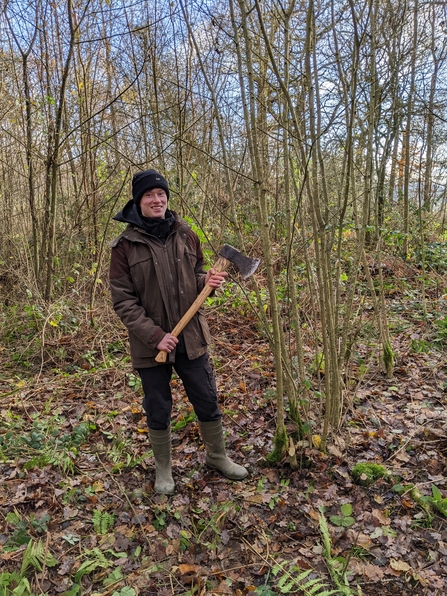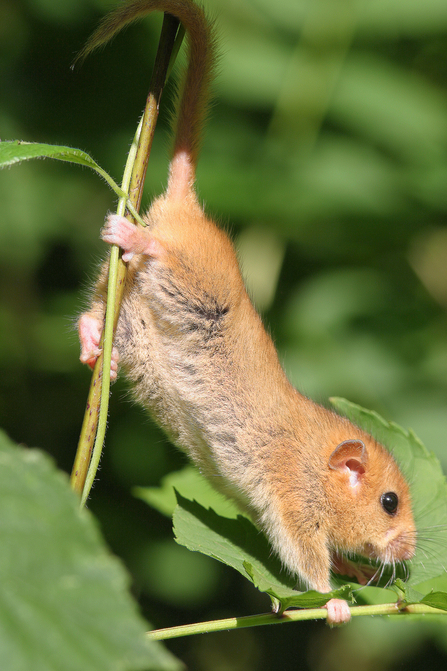Since joining the Green Farm project team, I find myself talking about coppicing at least once a day, sometimes even before my first caffeinated beverage. Coppicing often gets a bad rap from woodland wanderers who pass by a recently coppiced plot and think the landowner/manager must hate wildlife to do something so seemingly severe to a delicate woodland. Well, let’s explore the concept of coppicing and see how it stacks up.
The curious case of the coppice-worker
Wildflowers in Monkwood by Paul Lane

Charlie with a woodsman's axe
Coppicing is an ancient woodland management tool. It’s a somewhat symbiotic relationship between humans and wooded habitats, whereby the human (coppice-worker) manages the woodland in a way that enables them to harvest useful materials whilst creating a more diverse woodland structure. If you think this sounds like another language, then join me on an imaginary walk through Monkwood (or your local woodland) and all will become clear…
We arrive on a bright sunny November morning. Sunlight glistens through the last of the amber and ruby leaves, which cling tightly to branches as they wait for their moment of glory to dance and flutter from tree-top to forest floor.
As we pass through the gate and amble along the gravelly woodland track, our gaze moves to the right. A roughly rectangular area is encased in tall mesh fencing; within are fresh green shoots sprouting from tree stumps cut to almost ground-level and a few tall trees dotted in between.

Dormouse by Ian Pratt
Last year, folks arrived here with loppers and bow saws to cut hazel and willow to the ground. They kept a few select trees, to retain high-forest canopy and aerial connectivity so that beloved arboreal mammals (dormice to you and me) could still scamper around. With the absence of dense vegetation, dappled sunlight now reaches the woodland floor. Wildflower seeds, lying dormant in the soil, have the optimum conditions for germination and, come spring, a sweeping carpet of wild garlic, bluebell and wood anemone will appear.
As we continue on, we see another fenced area but the shrubby trees are so dense that you can’t see more than a couple of metres in from the track. This growth, taller than us, is the result of coppicing that was undertaken four or five years ago. Wildflowers at the woodland floor no longer receive enough light to grow and reproduce so their seeds lie dormant in the soil, waiting for suitable light levels and warmer temperatures to return when the plot is coppiced once again. Light-loving species no longer have optimal conditions but this dense growth provides a rich resource of fruits, flowers, seeds and nesting opportunities for birds and small mammals.
Hopefully, you’ve now got a better understanding of the importance of re-growth. Trees that are managed like this often live longer than their ‘unmanaged’ counterparts as they are less susceptible to storm damage or being blown over. They often have a greater volume of deadwood in pockets around the knuckle (the point at which the limb is repeatedly pruned), which is great for saproxylic invertebrates (bugs that chomp wood) and other creatures that live in the cracks and crevices or gnarly old wood.
Coppice stools by Wendy Carter
The stump left behind when shrubby species are cut down is called a coppice stool. Once cut, the stool will produce new shoots; in the first year, without the pressures of deer grazing, these could reach knee height or more. Over the course of the following 10-12 years, the multi-stemmed re-growth will grow tall and straight - perfect for making handles for tools or as building materials for simple structures.
People often remark that coppice plots are stark and brutal; they dislike the fencing and query why so many trees should be cut down when we should be trying to make the area better for wildlife. The truth is that coppicing, when done well, does make it better but you have to look at the woodland as a whole unit and not as individual plots. Good coppicing is done sensitively and rotationally, which means retaining standards (mature or fully grown high canopy trees like oak) within each plot, and not coppicing all plots at the same time.
Fencing, meanwhile, protects the delicate young shoots from being eaten by deer until the re-growth is mature enough to withstand browsing pressures. Once this occurs, fences are taken down to allow wildlife back into the coppice plot and are often re-installed around newly coppiced plots.
Coppiced woodland does a good job of mimicking the role of large herbivores that are now absent from our landscape. It creates dynamic and diverse woodland habitats that, when managed sustainably, creates conditions from dark and damp high canopy forest to an open and airy sun-lit woodland floor. By dividing the part of the woodland that we manage as coppice into multiple plots and cutting roughly one in every 12 plots each year, we ensure that there are diverse age structures and microclimates within the woodland.
In ensuring that the whole woodland contains this diverse array of habitat types, we can maximise biodiversity and create the necessary niches to support the widest possible range of plants, animals and fungi.


